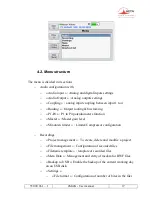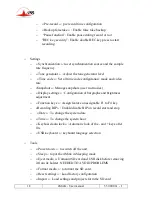
4
4MinX - User manual
55 000 061 - I
Input stage gain setting, 0dB to +50dB, 10dB steps;
Phantom power for a microphone, 48V, or “Tonader 12V” ;
Analog high-pass filtering, 50 Hz cut-off frequency, 18dB/octave;
Digital high-pas filtering, 50 Hz to 200Hz 12dB/octave and 300 Hz,
6dB/octave, suitable for compensating proximity effects in directional
microphones
Polarity inversion (phase reversal)
Fast limiting, with “soft knee”;
Routing to Left or Right bus, or Center (i.e. L and R), with pan-pot, or
not routed at all
The “risk of overload” LED begins to light at 12 dB below overhead.
Attenuator ( 20dB ) can be enable on the mic/line input 1 & 2
Note:
-
The 50Hz analog filter can be enabling in the same time as the digital
filtering. In this case rate will be 32dB/Oct below 50Hz.
-
A limiter can be inserted into each channel (post-fader). Its activation
is shown by a green LED that turns red when the signal begins to limit.
Stereo and M/S
Via menu selection, channels 1 and 2, 3 and 4 can be used as
independent channels or coupled for stereo or M/S operation. When used as a
couple of stereo or M/S channels, the channel impair becomes the master,
controlling the level of both channels. The channel pair provides
+/
-5dB
adjustment of the balance in L/R mode (normal stereo), or the stereo width in
M/S mode.
In normal stereo mode
, the transducers usually have matching sensitivity:
Any change of the input gain on one channel induces the same on
the other channel;
The even channel control controls the balance between L and R
channels by +/- 6dB
Summary of Contents for 4MinX
Page 2: ......
Page 68: ...62 4MinX User manual 55 000 061 I Specific monitoring for the B format L R ML SR SL S C MR ...
Page 77: ...55 000 061 I 4MinX User manual 71 ...
Page 83: ...55 000 061 I 4MinX User manual 77 ...
Page 85: ...55 000 061 I 4MinX User manual 79 8 3 Block diagram ...
Page 87: ...55 000 061 I 4MinX User manual 81 8 4 Level maps ...











































